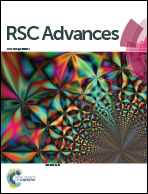Stripping voltammetric detection of copper ions using carbon paste electrode modified with aza-crown ether capped gold nanoparticles and reduced graphene oxide†
Abstract
Based on the unique electronic properties of reduced graphene oxide (RGO) as well as the selective interaction between kryptofix 21-capped gold nanoparticles (GNPs) with copper(II) ions, a novel electrochemical sensor for the detection of Cu(II) ions in aqueous solutions was proposed. The best voltammetric response for Cu(II) was obtained with a paste composition of 61% (w/w) of graphite powder, 4.0% (w/w) of kryptofix 21-capped GNPs, 5.0% (w/w) of RGO and 30% (w/w) of paraffin oil using a solution of 0.1 mol L−1 HCl, an accumulation potential of −0.4 V vs. Ag/AgCl (3.0 mol L−1 KCl) and accumulation time of 180 s. Under these optimum experimental conditions, a sensitive response to Cu(II) ions within a wide concentration range (0.5–75 μg L−1) was obtained. The proposed electrochemical sensor showed a low detection limit (0.1 μg L−1), below the guideline value from the World Health Organization (WHO) and the United States Environmental Protection Agency (USEPA). The modified electrode was successfully utilized for the determination of Cu(II) in different water samples, and good recoveries were obtained.


 Please wait while we load your content...
Please wait while we load your content...